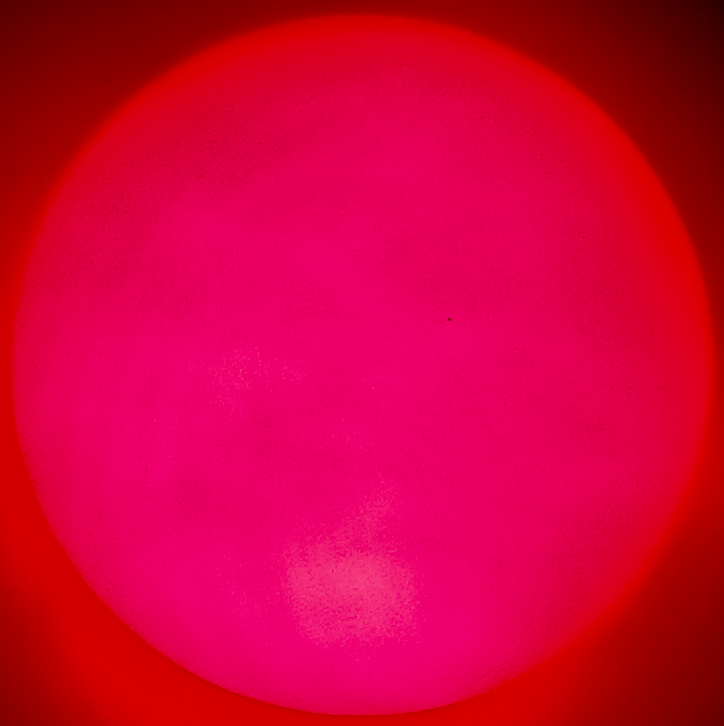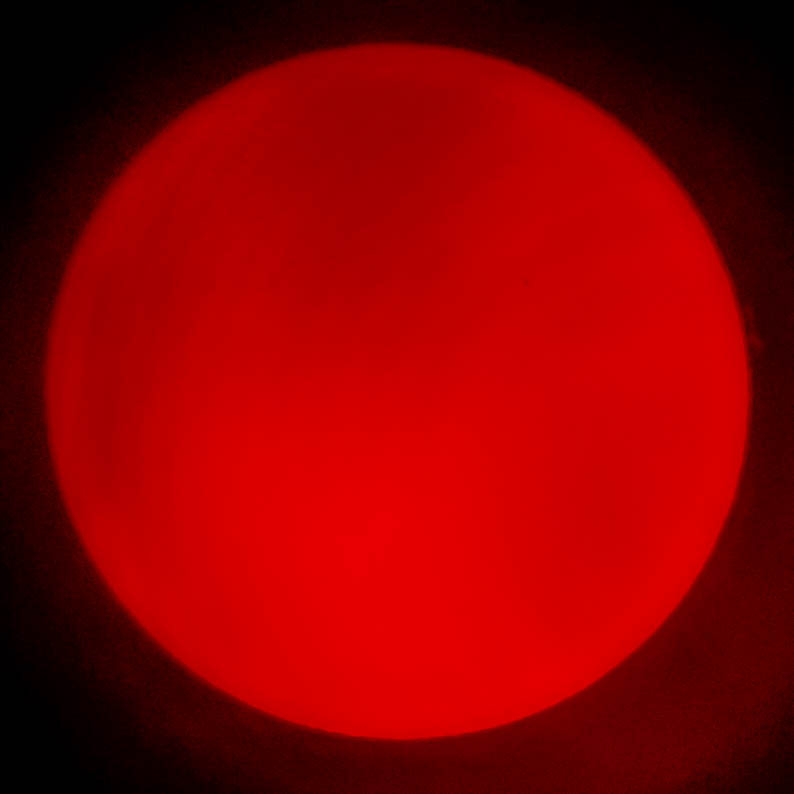A Beautiful Day for a Transit

The Mercury Transit was on a beautifully warm and sunny day — certainly warmer than the forecasts had had me expecting. The sun cleared the low buildings over the horizon very quickly, and the team was set up in East River Park by the time I arrived, at 7:30 a/m. in the morning. As soon as I set up the club’s Coronado PST solar scope, I estimated that Mercury was already 1/8th the distance between the center of the solar disc and the solar limb, and getting further ‘into’ the sun.
A father and son had been sitting at a park table, where I had set up, and I invited them over to take a look (they had already looked through the other telescopes in our ‘orchestra’). They enjoyed the view. I noticed that while I could not view sunspots (I had expected the sun to be ‘boring,’ given what I had seen from spaceweather.com), I could see a large prominence to the ‘right,’ of the sun (I think the Meade Coronado PST gives a right way up image, and that the image is not reversed, either) at 3 o’clock. There was also a large plume at about the 2 O’clock, as well as smaller spikes at the 1 O’clock, 4 O’clock, and 5 O’clock, as well as somewhere around 7 O’clock. Mercury was very close to the 1 O’clock, traversing the face like a messenger, as if handing itself over from the tip of a clock’s minute hand to perching itself on the hour hand, and then riding down that hand as if that hand started rolling backwards, thus resulting in Mercury passing over the center of the face of the Sun. It was quite a wonder, watching Mercury ‘float’ over the filaments on the ‘surface’ of the Sun, like a balloon floating over saffron yellow tree tops.
I took a peak at John Bills’ computer screen, as he shot from a combo H-Alpha and a white light system. Stan Honda, my personal guru for photography, was taking turns between shooting the sun through a white light filter at his camera’s front aperture, and doing some journalistic shots of the observers and the people who showed up.
Between talking to people who came to see us, and runners and cyclists, and walkers who stopped to take in a view, I stopped by at Roman’s white light setup, and B&H’s Christopher Witt’s double stacked Meade Coronado SolarMax 90mm aperture solar telescope. This club truly has me getting spoiled!
Someone working at the composting project, just south of the observing site behind the Amphitheater at East River Park, showed up — just out of curiosity. He was happy to observe for a few minutes. Many others dropped by. Two people told me they heard about us from some radio station with a name ending with ‘NYC.’ One gentleman told me he heard about us from NPR. Another person said he heard about observing sites from some broadcast, then googled observing sites near him, which sent him to Space.com, which had our club’s Mercury Transit Observing page listed, which then brought him to our observing site. Personally, I heard similar stories of voice broadcasts (like radio) and web searches (like Google) from a few others who came our way. I was delighted for the shoutouts.
Many parents came by so that their kids could observe. Many came as entire families. Many showed up singly, or with friends. Some complained about not knowing where to find us, and that they had to walk around to look for us. Others made a beeline for us the moment that they departed from their mode of transportation.
Soon after I set up we were joined by Elaine Smyth, and then Alan Faitelewicz, both with 90mm white light telescopes. We were joined by other members of the club, sans telescope. I forget the names of all of those members, but I do remember Emily Bunin, Richard Sutor, and Michael Towers. I had hoped that at least one of them could have stayed longer (I had an ulterior motive).
Roman Barroso did a Spanish Language broadcast of the transit, on site. Stan Honda gave the club a 15 second video intro, for B&H Photo. We got a visit from Brian Levine, from Astronomy On Tap.
We were joined by a new club member, Faisal Shahim (no, he’s not me — we’re like Thomson and Thompson, from the Tintin cartoons). I then broke out the club’s 50mm Lunt solar telescope (this was why I had hoped that someone from the club without a telescope would stay longer), and he got an intro in operating it. Of course, he was like a kid in a candy store, and I had fun reliving when I was new to the club, back during the Mercury Transit of 2016 (and yes, that Lunt was how Marcelo got me mesmerized to the draw that is solar astronomy — Marcelo, you Lunt Whisperer).
I lost count of how many people looked through the club’s Coronado, or the Lunt, let alone how many stopped by to observe with the group.
We got excited people stopping by all the way to the end. I remember one-person observing through the Coronado as the transit ended. Soon after, a lady dropped by with her little children, and she had kids observe the sun through our scopes. The kids also played with the solar viewing eyeglasses that had been left on a park table.
One person showed up just after I had broken down, and we passed by another person, after packing up, who had been coming to observe with us.
The birds were shining, the Sun was singing, and I was happy to be stuck on an island with the AAA.












































